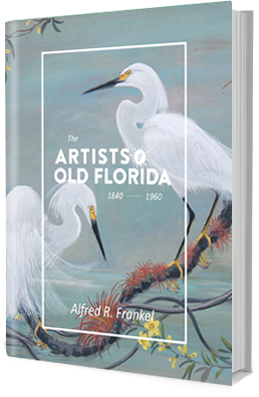Albin Polasek (Czech/American, 1879-1965), Man Carving His Own Destiny, 1917.
Bronze, cast signature. Height 19 ¾”, width 12 1/2”, depth 7”.
The following is by Debbie Komanski, Executive Director, Albin Polasek Museum, Winter Park, Florida.
Albin Polasek was a 20th Century sculptor, working in stone, bronze, plaster, and wood. He also did occasional painting. Polasek’s legacy is the sculpture he created, primarily figurative works, with which he strove for sound construction and reflection of the true structure of nature such as the unity of head or figure and the beauty of movement- the flow of one mass into another-which made the difference between a living work and something inanimate.
Polasek was born in 1879 in Ferstat, Moravia (now Czech Republic) and was apprenticed as a wood carver in Vienna before immigrating to the United States in 1901. He continued to work as a wood carver in the Midwest until 1906, when he began formal art studies at the Pennsylvania Academy of the Fine Arts. Under Charles Grafly, Polasek learned traditional classical sculpting techniques, while refining his own distinct style. As a student he completed his first works that got public attention, Man Carving His Own Destiny (1907), and The Eternal Moment (1909). In 1909 Polasek became an American citizen. The following year he won the Prix de Rome competition and accompanying three-year fellowship at the American Academy of Art in Rome. He earned an Honorable Mention at the 1913 Paris Salon for The Sower (1913), a piece created during his time in Rome. Completing his studies in Italy, Polasek returned to New York and opened his own studio. In 1916 he became head of the Department of Sculpture at the Art Institute of Chicago, a position he retained for thirty years. He gained a reputation as a Chicago artist because he created many landmarks-monumental sculptures throughout the city.
Albin Polasek (Czech/American, 1879-1965), Aspiration. Bronze, stamped with artist’s name and copyright. Height 16”, width 13.”
In 1950 Polasek retired to Winter Park, Florida, to a home he designed on Lake Osceola. His longtime companion and former student, Ruth Sherwood, had moved to Winter Park several years earlier and the couple married in December 1950. It was the first marriage for both; Polasek was 71, Sherwood was 61. Sherwood died eighteen months later. Just after moving to Winter Park, Polasek suffered a stroke that left the left side of his body paralyzed. Although he spent the remainder of his life in a wheelchair, he continued to paint, draw, sculpt clay, carve wood and, with assistance, carve stone.
Post-stroke, Polasek spent a great deal of time perfecting and reproducing his best-known works, but also creating newer, more intimate pieces. In 1961 Polasek married a second time, to Emily Muska Kubat. That year the pair established the Albin Polasek Foundation to share with the public his life’s works. They began buying back some of the 400 works Polasek created during his lifetime and opened his estate to the public as the Albin Polasek Museum. Today, 200 of Polasek’s pieces are currently on Museum property. Upon his death in 1965 Polasek was buried in Winter Park’s Palms Cemetery with his sculpture, 12th Station of the Cross (1939), as his monument. Emily Polasek died in 1988. *From Debbie Komanski, Executive Director, Albin Polasek Museum, Winter Park, Florida.
Albin Polasek (Czech/FL, 1879-1965), Mother Crying Over the Earth. Patinated bronze, inscribed ‘A. Polasek, 1992’ on front of base, the top of the underside signed ‘Polasek, Mother Earth’. Height 13 ½”, width 13”, depth 10”.
Born: February 1879, Frenstat, Czechoslovakia. Died: 1965, Winter Park, Florida. Education: Pennsylvania Academy of the Fine Arts; American Academy, Rome; with Charles Grafly. National Academy of Design; National Sculpture Society; New York Architectural League; Southwest Society; Chicago Society of Artists; American Federation of Arts; Alumni Association of the Fellowship of American Academy in Rome. Membership: Norton Gallery and School of Art, West Palm Beach. Exhibits: Prix d Rome, American Academy, Rome, 1910; Paris Salon, 1913, honorable mention; Pennsylvania Academy of the Fine Arts, 1914, Widener Gold Medal; Art Institute Chicago, 1917, Hearst Prize; Art Institute of Chicago, 1917, 1922 Logan Medal; Milwaukee Art Institute 1917, medal; Chicago Society of Artists, 1922, silver medal; William Merritt Chase, bust, presented to New York University by ninety-two former artists and pupils of Chase, August 1923; Theodore Thomas Memorial, Chicago, 1924; Fairmount Park Art Association Prize, Pennsylvania Academy of the Fine Arts, 1925; Chicago Art Institute, 1926, Order of the White Lion, for sculpture of Woodrow Wilson now in Czech Republic; Radigast (1929), Sts. Cyril and Methodius (1929) in Czech Republic; Chicago Galleries Association, prize, 1937; Chicago, Masaryk Memorial, 1941; Work: Metropolitan Museum of Art, New York City, Fantasy; Pennsylvania Academy of the Fine Arts, Philadelphia, bust, F.D. Millet; Art Institute of Chicago, busts, Charles Hawthorne, Charles L. Hutchinson, Frank G. Logan; Detroit Institute of Art, Aspiration; Richard Yates Memorial, Springfield, Illinois; J.G. Batterson Memorial, Hartford, Connecticut. Manatee County Art Center, Bradenton, February, 1960.





